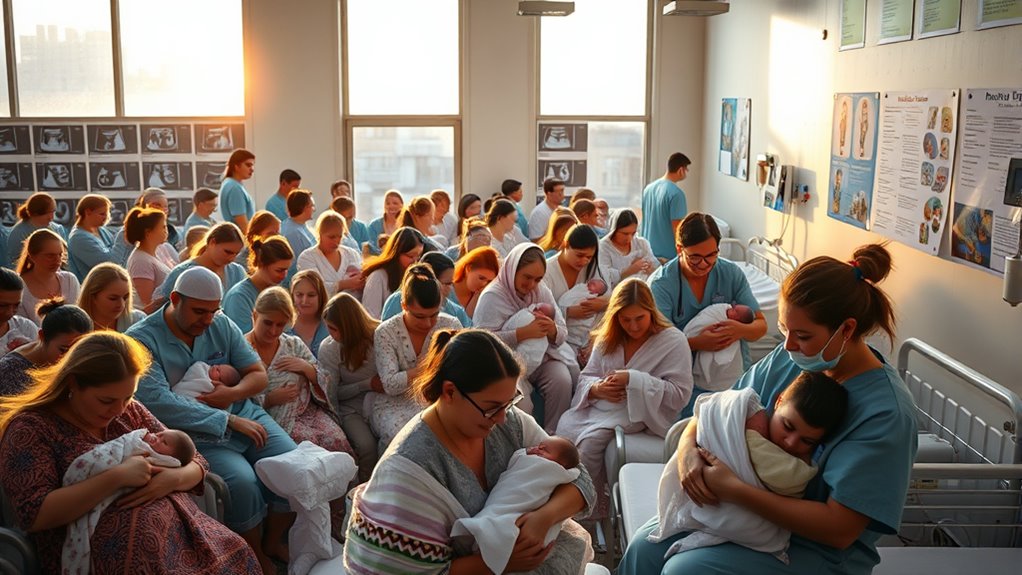Demographers warn that the recent U.S. birth rate bump is likely just a short-term fluctuation, not a sign of lasting change. They point to factors like economic uncertainty, pandemic-related stress, and policy shifts that may only temporarily boost birth numbers. As economic conditions tighten or social factors shift again, birth rates could decline. If you’re curious about what influences these trends and what might drive the rebound to fade, there’s more to explore ahead.
Key Takeaways
- The recent birth rate increase may be driven by temporary factors, not reflecting long-term demographic shifts.
- Economic uncertainties, such as inflation and job instability, could cause families to postpone or reconsider childbirth.
- The rebound might be concentrated in specific regions or demographics, limiting its nationwide sustainability.
- Pandemic-related policies temporarily boosted birth rates, but their rollback could reverse gains.
- Psychological impacts and social shifts post-pandemic may continue to influence fertility decisions negatively over time.

After experiencing a noteworthy decline during the pandemic, the birth rate in the U.S. is now showing signs of a rebound. However, demographers warn that this upswing might not last long. Several factors influence this trend, and understanding them helps explain why the rebound could be temporary.
One of the main reasons for the recent increase is the ongoing economic recovery. As the economy improves, people tend to feel more confident about their financial stability, which can lead to a decision to have children. When job markets strengthen and incomes stabilize, prospective parents often see parenthood as a more feasible goal. Yet, this optimism may be delicate if economic conditions falter again. If inflation rises or unemployment spikes, families might postpone or reconsider their plans, causing birth rates to dip once more.
Economic recovery boosts birth rates, but fragile confidence risks future declines.
Policy impacts also play an essential role in shaping birth trends. During the pandemic, government policies, including stimulus payments and expanded parental leave, temporarily eased financial pressures and encouraged childbirth. Now, as some of these supports fade or are rolled back, the impetus for having children could weaken. For example, changes in healthcare policies, childcare availability, or family leave regulations can directly influence decisions about expanding families. If policies become less supportive or less accessible, it may suppress the recent rebound in birth rates. Additionally, the long-term effects of policy changes can further influence demographic patterns over time.
Demographers also point out that the timing of the rebound might be misleading. The increase could be driven by a small number of regions or demographic groups, rather than a nationwide trend. Younger adults, who are more sensitive to economic and policy shifts, might delay childbirth once uncertainty resurfaces. Meanwhile, older parents, who already have children, might not significantly influence overall birth rates. This uneven impact suggests that the current rise might not be sustainable across all segments of the population. It’s important to consider regional variations when analyzing these trends to avoid overgeneralization. Moreover, psychological factors such as pandemic-related anxiety and uncertainty continue to play a significant role in family planning decisions. Additionally, the influence of social and cultural shifts is increasingly evident, as evolving attitudes towards family life and work-life balance reshape fertility decisions in complex ways.
Frequently Asked Questions
How Does the U.S. Birth Rate Compare Internationally?
You might notice that the U.S. birth rate is generally lower than in many developing countries but higher than some European nations. Cultural influences and fertility preferences shape these differences, with Americans often delaying childbirth or having fewer children. International trends vary, but the U.S. continues to see fluctuations influenced by economic factors and societal attitudes, which can cause short-term rebounds or declines in its birth rate.
What Are the Long-Term Demographic Impacts of Fluctuating Birth Rates?
Persistent population pulses can profoundly impact your future. When birth rates fluctuate, you’ll see long-term demographic shifts like population aging, which strains social services, and a shrinking labor force that can slow economic growth. These changes challenge your community’s resilience, requiring adaptive policies to support aging populations and attract talent. Understanding these long-term impacts helps you prepare for a future where demographic dynamics shape economic and social landscapes.
How Might Policy Changes Influence Future Birth Rate Trends?
Policy changes can markedly influence future birth rate trends by offering stronger incentives for families. You might see increased policy incentives like paid family leave or tax benefits, making it easier for you to have children. Enhanced family support programs provide resources and stability, encouraging you to expand your family. These efforts can boost birth rates by reducing financial and social barriers, shaping a more sustainable demographic future for the country.
Are There Regional Differences Within the U.S. in Birth Rate Recovery?
You might wonder if the U.S. birth rate recovery is uniform across regions. The truth is, regional disparities and cultural influences create a varied picture. Some areas see a quick rebound, fueled by local policies and norms, while others lag behind. These differences hint at a complex future, where geography and culture shape birth trends uniquely, making it essential to watch regional patterns closely for a clearer understanding.
What Role Does Economic Stability Play in Fertility Decisions?
Economic stability plays a crucial role in your fertility decisions. When you feel secure about your financial future, you’re more likely to think about having children, as economic security reduces stress and uncertainty. Conversely, lack of financial stability can delay or discourage childbirth. Your ability to plan and provide for a family depends heavily on your perception of economic health, making financial stability a key factor in reproductive choices.
Conclusion
So, hold onto hope, but keep your eyes open. The recent bounce in U.S. birth rates might be just a fleeting spark in a long winter’s night. Like a fragile bubble, it could burst as quickly as it appeared, swallowed by economic worries or shifting priorities. Stay alert, because the future of these numbers depends on the unpredictable winds of change—what’s bright today might fade away before dawn.
Amina brings over a decade of journalism experience to her role as Editor-in-Chief. Under her leadership, Exquisite Post has flourished, maintaining the highest standards of integrity and excellence. Amina’s commitment to truth and her visionary approach guide the editorial team in producing impactful news stories that resonate with our audience.










